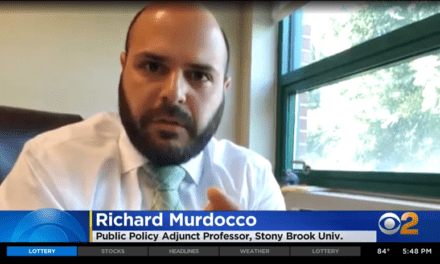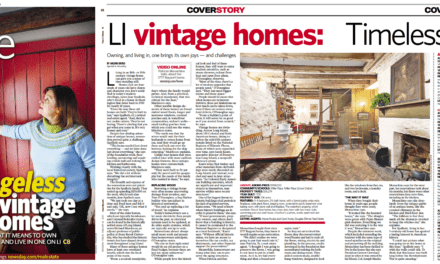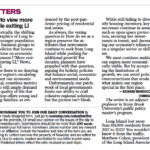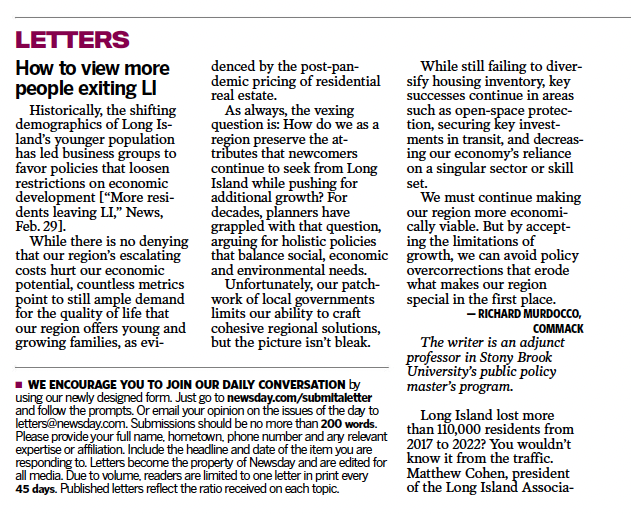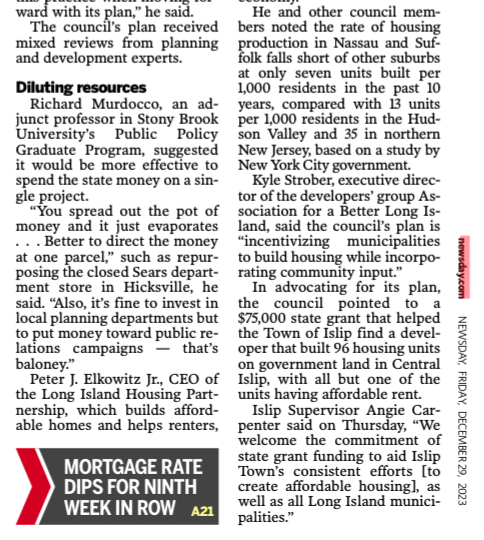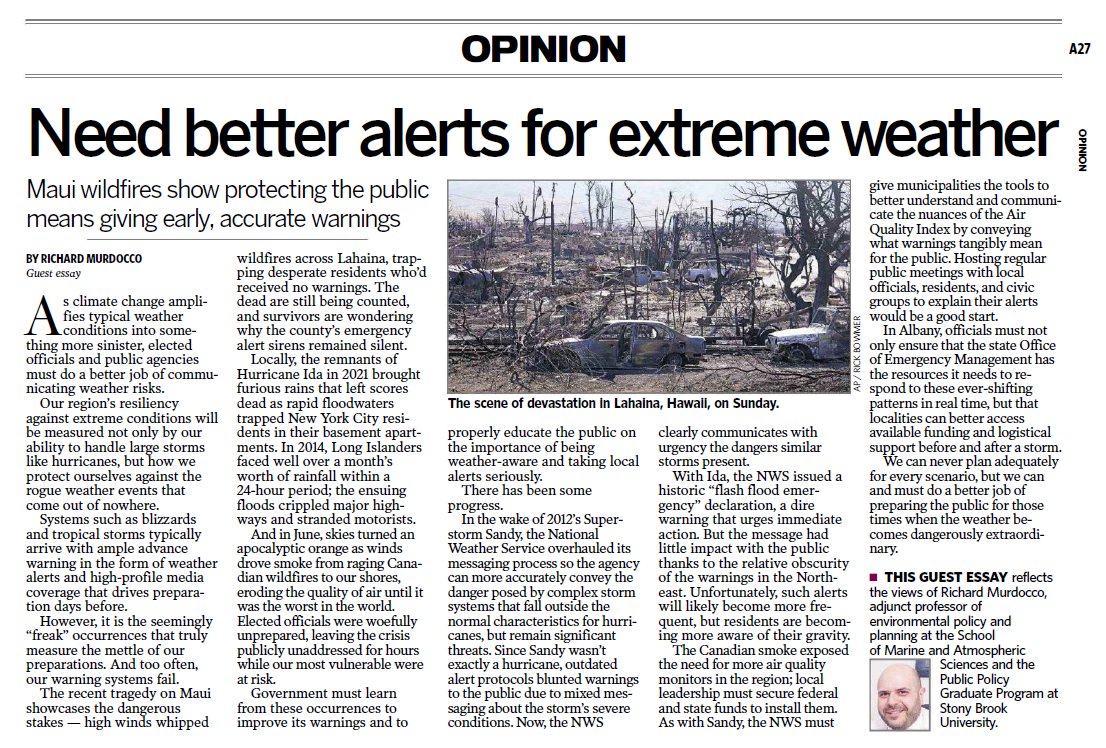The following was published on May 16th, 2014. It was written by Steven Rossin, a journalism student from SUNY Stony Brook who was conducting research regarding the development of sewers for the Mastic-Shirley area. You can view the original piece online here.
Could Sewers Help the Mastic-Shirley Community?
by Steven Rossin
Mastic and Shirley are two hamlets along the Town of Brookhaven’s South Shore that need a major facelift.
According to the 2010 U.S. Census, Shirley has a poverty rate of 9.1 percent. Mastic’s is at 11.4 percent. Both are higher than the county average at 6.1 percent. Some residents, local politicians and local business and real estate interests are pushing for a sewer system, saying it’s the only thing that will bring new businesses and jobs to the area.
The two communities are trying to jumpstart revitalization efforts through the creation of a sewage treatment plant on 20 acres of land at Brookhaven’s Calabro Airport. The district would serve 1,400 acres and an estimated 3,899 lots, going east from the west side of William Floyd Parkway, across Montauk Highway to the Forge River. It also extends south from Sunrise Highway for about two miles. The district will serve most residential areas near the Forge River and businesses on Montauk Highway.
Without sewers, these advocates say, businesses looking to move in or expand are limited by the capacity of their cesspools. The community desperately wants the jobs and increased tax revenue that a bigger business district could offer.
“When you have septic systems you’re limited, [cesspools] really limit what we can have here,” said Joshua Slaughter, a staff aide to County Legislator Kate Browning.
The Suffolk County Legislature has approved $1 million for planning towards the final design for the proposed Mastic-Shirley Sewer District, the last step before getting funding for construction. Estimates indicate that building the district would cost roughly $350 million.
That $350 million would be raised through a combination of property taxes, government grants and possibly money from Hurricane Sandy programs. It’s the question of how much taxpayers would have pitch in that may stall the proposal.
Environmentalists are strongly behind the project, which would restore water quality in the heavily polluted Forge River, which runs through Mastic on its way to Moriches Bay. If the district is constructed, it would be the largest undertaking for a Long Island sewer project since the construction of the Southwest Sewer District in southwestern Suffolk County 35 years ago.
The story of the Applebee’s restaurant in Shirley illustrates the stakes.
The Applebee’s franchise, located just off of William Floyd Parkway, is one of the few eating establishments in the downtown district – and it took years for the restaurant to get septic approval. When it did get approval, the restaurant ended up being only half the size the owners really wanted because of the limitations posed by the cesspool on their property.
Slaughter said situations like these have made businesses wary about coming to the area.
“We don’t have the septic capacity to really attract investors and developers for the kind of establishments that the community really wants here,” he said.
Community leaders agree, and say that as long as the price is right, sewering could help new and existing businesses. And they say it’s about time that the area got the attention of county officials.
“This community is always overlooked,” said Beth Wahl, president of the William Floyd Community Summit. “We’re like the ugly redheaded stepchildren of Suffolk County,”
Wahl, along with other members of the William Floyd Community Summit, has pushed to bring sewers to the area for over a decade.
“Without them, we’re never going to have an economy boost in this community,” Wahl said. “A beautiful piece of property right on the corner of Montauk Highway and William Floyd Parkway sits there empty. My vision is a beautiful seafood and steakhouse restaurant right there. It’ll never happen unless we have sewers.”
Anthony Liberti, a real estate agent in Mastic, said new sewers would be a tremendous benefit to the Montauk Highway business corridor, adding that it could bring in additional restaurants and more traffic. Without sewers, he said, it will be difficult for the local economy to improve.
“If we had sewers, our Main Street would be flourishing,” Liberti said. He envisions restaurants and affordable housing that would help keep younger people in the community.
“There are a lot of pluses,” he said.
Legislator Browning and Slaughter have been moving the district forward, working with consultants and helping secure the airport site. They said they hope that building sewers will help attract developers to the business corridor on Montauk Highway.
“We’ve spoken to developers in the past and they basically say, ‘Well, you don’t have sewers,’” Slaughter said. “It’s really all about sewers for them, and they’re not even going to sit at the table until we have them.”
The new sewer district would not only provide potential economic benefits downtown, but it would also improve water quality in the Forge River, which flows south from Sunrise Highway, past Montauk Highway and into Moriches Bay.
The Forge River was classified as a damaged water body in a series of studies prepared for the Town of Brookhaven by the School of Marine and Atmospheric Sciences at Stony Brook University. Its 2009 study, “Forge River, Problems Identification” found an increase in sewage discharged into the river from cesspools and septic systems. Researchers recommended construction of a sewage treatment plant.
“The Forge River used to be such a beautiful recreation facility, and fishing was a big thing,” Wahl said. “There are no fish now, and the river is basically dead. When you drive by sometimes, the stench is unbelievable.”
Slaughter said that the new system would significantly reduce the nitrogen that goes into the river. According to the Draft Feasibility Study from September 2013, the nitrogen load from sewage under current systems is 229 pounds per day. Replacing antiquated septic systems with sewers would reduce that load to 69 pounds.
“Seventy percent of the nitrogen that is currently flowing into the river will be eliminated, and that’s a huge impact,” Slaughter said. “You’ll see changes within that river within two to five years.”
David Tonjes, a professor at Stony Brook University’s School of Technology and Society, explained that the reason for such a timetable is because groundwater takes a fairly long time to travel. Tonjes added that some researchers see the fate of the Forge as an example of what could happen to other waterways in the area.
“The Forge River is the poster boy for what could happen to Long Island’s estuaries in some people’s accounts, especially if we don’t sewer,” he said.
He sees the benefit of sewering the area around the Forge River, but also says that it shouldn’t be a template to make countywide decisions.
Sewers are not cheap to build, and they are not cheap to operate either, Tonjes said. If increased sewering were to occur elsewhere in Suffolk County, he said, property taxes could go up considerably in each new sewer district. Alternatively, the county could create an agency that would issue bonds. The debt service on those bonds would also come from district property owners, but more slowly.
Going forward, Slaughter said, the main concern is that if more than 50 percent of the district’s funding comes from the community tax base, the community could not afford it. The tax burden on local property owners would just be too much.
And that’s not even counting the cost of hooking up individual homes, costs paid by property owners and passed on to the many renters in the area.
No hookup cost has been set yet, but according to homeadvisor.com, the average New York homeowner pays $3,525 to hookup to a sewer.
Richard Murdocco writes about regional land use planning for the Long Island Business News and his own website, thefoggiestidea.org. He also holds a master’s degree in public policy from Stony Brook.
He has supported the efforts to bring sewers to the Mastic-Shirley community. In fact, he said, sewers there are long overdue, and it’s a miracle progress has been made. And while he is glad about potential growth, he also stressed that, as with anything else, there needs to be a balance. Sewering may not be the answer everywhere.
Among the other Suffolk communities where sewers have been discussed as an economic stimulus are Riverside and Flanders in northern Southampton Town.
“There’s no silver bullet approach when it comes to wastewater on Long Island,” Murdocco said. “Sewers have their own host of problems.” Besides construction and operating costs, these problems might include increased costs for the county health department, which would regulate the districts.
Once the district is formed, Murdocco explained, the job is not over. A mismanaged wastewater system can be just as bad as an antiquated cesspool if not properly regulated or maintained. To keep a new sewer district running smoothly, he said, the name of the game is funding.
If the proposed Mastic-Shirley Sewer District gets its funding, the district would be the largest wastewater system to be constructed since the Southwest Sewer District was built in the late 1970s. Originally, voters passed a referendum to construct the district for $291 million, but those costs later increased to $640 million ($1.8 billion in 2014 dollars). Most of the district was south of Montauk Highway in the towns of Babylon and Islip, land that is similar to the Mastic-Shirley area with a high water table that often leads to flooding.
There were many delays during construction, and the project went over budget. Lee Koppelman, director of the Center for Regional Policy Studies at Stony Brook University, said there was a lot of corruption associated with the project and that district residents quickly got fed up.
“It became quickly apparent that the cost for people in the sewer district would be more than they could handle tax-wise,” he said.
Politically, there were many negatives. Koppelman said the Suffolk County Republican Party turned the sewer agency into a political boondoggle, and County Executive John Klein was slow to respond to the scandal. As a result, Klein was challenged within his own party for his position and lost a primary election to Peter Fox Cohalan. Developers went to jail, and other politicians followed Klein out of office.
Since the ordeal of the Southwest Sewer District, Koppelman said, he believes most Long Islanders are less receptive to new sewer infrastructure in their communities. He says that aside from Mastic and Shirley, the attitude in most areas is that if businesses want new sewers, let them pay for it,. This, he added is a very difficult proposition. Unless funding is sufficient to mitigate the tax impact locally, he said, those attitudes are unlikely to change.
“Politically, it is such a hot potato, no elected official even wants to talk about… because the citizens realize aside from ripping up the streets and the disruption while the sewer program is carried out, it’s going to raise their taxes,” he said.
Ray Keenan, a Shirley resident and the president of the Manor Park Civic Association, said the Montauk Highway commercial area isn’t in desperate need of a costly district, but rather, better sewage treatment. For example, he said, businesses could have on-site sewage treatment and pay for it themselves.
“I think the whole plan was askew in the first place and that they really needed to look at other options,” Keenan said. “There is technology now where they can do it on-site. You don’t need to build sewers or rip up roads. There is no need to be taxing people for the creation of a sewer district.”
Murdocco says that when it comes to sewers on Long Island, it really comes down to maintaining a fine balance. Sewers would be no guarantee that the community’s economy would improve dramatically.
“You have to balance economic development with the environmental side of things and balance that social equity,” Murdocco said. “Sewers are really helpful, but with that being said, you can’t just sewer off residential neighborhoods and then expect to build apartment buildings. That’s not how it works.”





